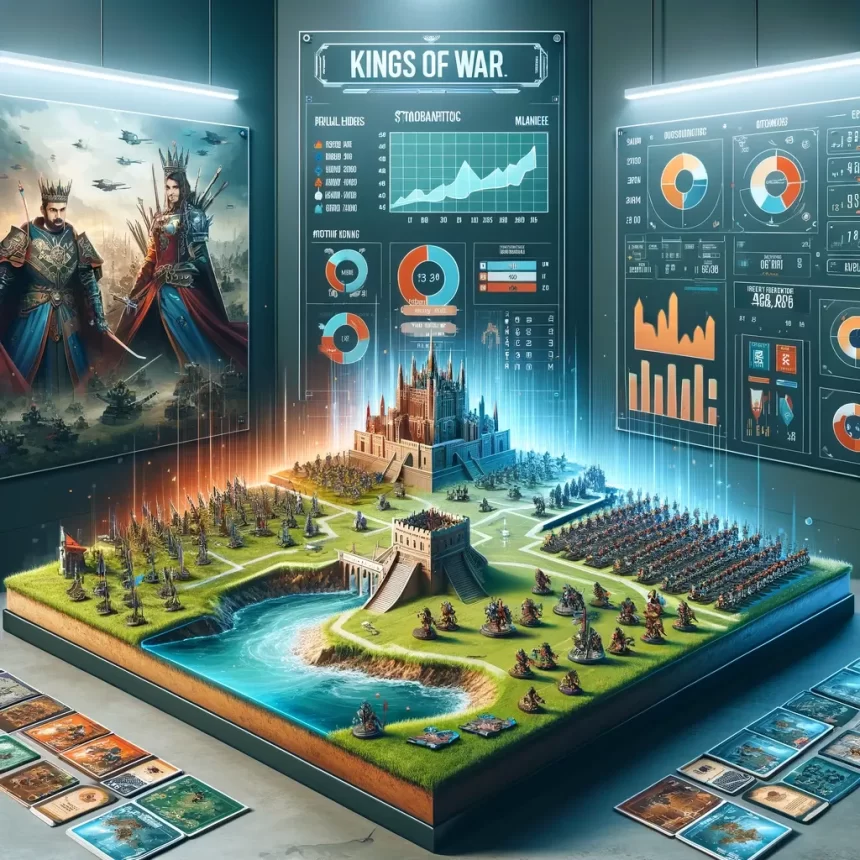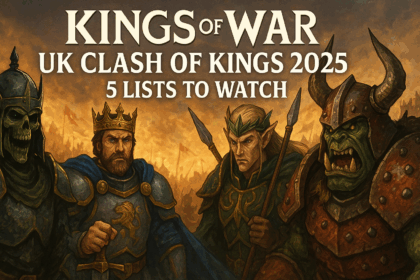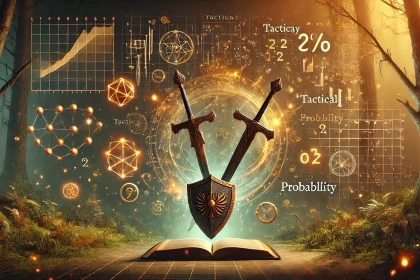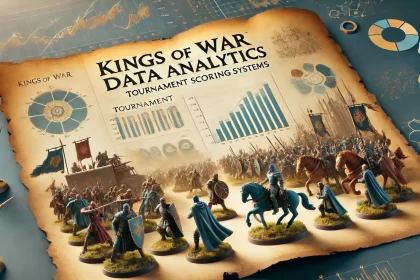Leading up to the US Masters, I compiled an analysis of all the participating lists, breaking them down by various factors such as drops, scoring drops, unit strength, average speed, and more. The question was: would any of these factors actually predict the tournament outcomes? Were there any bogeyman lists that were legitimate concerns? Now that we have the tournament data, we can find out! I extracted the data from Tabletopscore, analyzed it with Python,1 and here’s what I found. First, let’s take a look at the player results:
| Player | Faction | Wins | Losses | Draws | AvgScore | Elo |
| Luke Fraser | Trident Realm | 5 | 0 | 1 | 16.7 | 1760 |
| Jeffrey Schiltgen | Ogres | 5 | 0 | 1 | 15.5 | 1722 |
| Jeff Radigan | Forces Of Nature | 5 | 1 | 0 | 15.0 | 1690 |
| Jeff O’Neal | Goblins | 5 | 1 | 0 | 13.8 | 1687 |
| Nathan Clevenger | Nightstalkers | 5 | 1 | 0 | 14.8 | 1686 |
| Sean Troy | Ratkin | 5 | 1 | 0 | 14.0 | 1673 |
| Justin Robbins | Ogres | 5 | 1 | 0 | 14.0 | 1667 |
| Keith Randall | Elves | 4 | 1 | 1 | 13.0 | 1620 |
| Mark Cox | Northern Alliance | 4 | 1 | 1 | 12.2 | 1614 |
| Kevin Drury | Varangur | 4 | 2 | 0 | 13.2 | 1603 |
| Eric Schaefer | Elves | 4 | 2 | 0 | 13.0 | 1597 |
| Dustin Howard | Empire Of Dust | 4 | 2 | 0 | 12.3 | 1577 |
| Jordan Braun | Forces Of Nature | 4 | 2 | 0 | 12.5 | 1569 |
| Jared Holcomb | Goblins | 4 | 2 | 0 | 10.2 | 1569 |
| Keith Monach | Salamanders | 4 | 2 | 0 | 12.8 | 1565 |
| Marcelo Rouco | Green Lady | 3 | 2 | 1 | 13.7 | 1563 |
| Grant Fetter | Basileans | 4 | 2 | 0 | 11.2 | 1559 |
| Erich Trowbridge | Dwarfs | 3 | 2 | 1 | 12.2 | 1558 |
| Shawn Polka | Forces Of Nature | 4 | 2 | 0 | 10.5 | 1558 |
| Dale Motley | Dwarfs | 4 | 2 | 0 | 11.5 | 1553 |
| Michael Sigler | Forces Of The Abyss | 4 | 2 | 0 | 10.8 | 1543 |
| Cory Walizer | Ogres | 3 | 2 | 1 | 11.8 | 1539 |
| Jesse Berglund | Elves | 4 | 2 | 0 | 10.5 | 1530 |
| Tom Annis | Dwarfs | 3 | 3 | 0 | 12.2 | 1520 |
| Jon Becker | Ogres | 3 | 3 | 0 | 11.7 | 1513 |
| Joseph Borgese | Dwarfs | 3 | 2 | 1 | 10.2 | 1506 |
| Kyle Pietsch | Dwarfs | 3 | 3 | 0 | 10.8 | 1501 |
| Garrett Mercier | Salamanders | 3 | 3 | 0 | 12.3 | 1498 |
| Mike Rossi | Dwarfs | 3 | 3 | 0 | 11.5 | 1496 |
| Mike Grant | Herd | 3 | 3 | 0 | 11.5 | 1489 |
| Nicholas Murray | Undead | 3 | 3 | 0 | 10.5 | 1486 |
| Jason Birr | Elves | 3 | 3 | 0 | 10.8 | 1483 |
| Dustin Church | Herd | 3 | 3 | 0 | 10.7 | 1477 |
| Tyler Schulz | Empire Of Dust | 3 | 3 | 0 | 9.8 | 1475 |
| Ryan Munsell | Dwarfs | 3 | 3 | 0 | 9.7 | 1470 |
| Alex Chaves | Dwarfs | 2 | 3 | 1 | 10.7 | 1460 |
| Ray Weiandt | Forces Of The Abyss | 3 | 3 | 0 | 9.7 | 1456 |
| Eldon Jr Krosch | Goblins | 3 | 3 | 0 | 10.0 | 1456 |
| Timothy Smith | Undead | 3 | 3 | 0 | 10.3 | 1455 |
| Devlin Smith | Sylvan Kin | 2 | 3 | 1 | 9.8 | 1448 |
| Billy Henninger | Trident Realm | 3 | 3 | 0 | 9.0 | 1442 |
| Jesse Garrett | Forces Of The Abyss | 2 | 4 | 0 | 11.0 | 1433 |
| Brinton Williams | Abyssal Dwarfs | 2 | 4 | 0 | 9.0 | 1399 |
| Daniel Wright | Halflings | 2 | 4 | 0 | 9.5 | 1394 |
| Bruce Monach | Undead | 2 | 4 | 0 | 10.3 | 1392 |
| Brian Ring | Elves | 2 | 4 | 0 | 8.2 | 1384 |
| Cyle Pool | Goblins | 2 | 4 | 0 | 8.8 | 1384 |
| Lex Simon | Basileans | 2 | 4 | 0 | 8.2 | 1373 |
| Bryce Clark | Forces Of The Abyss | 2 | 4 | 0 | 7.8 | 1368 |
| Blake Robertson | Nightstalkers | 2 | 4 | 0 | 7.5 | 1367 |
| Daniel Johnson | Forces Of Nature | 2 | 4 | 0 | 8.5 | 1366 |
| Jared Mcclure | Trident Realm | 2 | 4 | 0 | 7.8 | 1366 |
| Benjamin Mcclure | Abyssal Dwarfs | 2 | 4 | 0 | 8.0 | 1365 |
| Ryan Smith | Northern Alliance | 2 | 4 | 0 | 7.2 | 1364 |
| Stephen Derose | Varangur | 2 | 4 | 0 | 8.0 | 1363 |
| Russell Romano | Elves | 2 | 4 | 0 | 6.0 | 1354 |
| Kenneth Heisler | Orcs | 2 | 4 | 0 | 6.8 | 1352 |
| William Stein | Forces Of The Abyss | 2 | 4 | 0 | 7.0 | 1326 |
| Benjamin Weisert | Ogres | 1 | 5 | 0 | 5.8 | 1304 |
| John Blakemore | Dwarfs | 1 | 5 | 0 | 8.3 | 1298 |
| Andrew Minton | Salamanders | 1 | 5 | 0 | 6.8 | 1286 |
| Lance Hatcher | Salamanders | 1 | 5 | 0 | 6.7 | 1276 |
| Benjamin Stoddard | Forces Of The Abyss | 1 | 5 | 0 | 6.3 | 1271 |
| Nate Murray | Ogres | 0 | 6 | 0 | 3.3 | 1121 |
If you’re not familiar with Elo ratings, it’s a system commonly used in one-on-one games like chess. Essentially, your rating is compared to your opponent’s before the match. If you perform better than expected, your rating increases and vice versa. This means that a narrow loss against a strong opponent can actually increase your rating, while a less-than-impressive win against a weaker opponent can decrease your rating.

So, which factors in the army lists had the most significant impact on the outcomes? To find out, I performed a correlation analysis to see which factors were most strongly associated with the final Elo ratings. The results were enlightening:
- Number of Nimble Units: Kings of War is a game of movement, so each nimble unit adds flexibility and opportunity. This factor had a positive correlation with Elo rating.
- Number of Missile Units: These are individuals used to kill war machines or ground flyers. Surprisingly, the more of these a player had, the lower their Elo rating.
- Total Amount of Regen: This factor had a negaptive correlation with Elo rating. It might be a spurious correlation due to the limited sample size, but it suggests that having a lot of regen units isn’t necessarily a winning strategy.
- Number of Chaff Units: The more chaff units a player had, the better their charges, which can be critical in the piece trading game.
- Number of Total Ranged Attacks: While damage output is important, being able to attack enemies from a distance before engaging in close combat seemed to pay dividends against a tough masters field.
Next, I aggregated the data by faction:
| Faction | Wins | Losses | Draws | WinPct | AvgScore | Elo |
| Ratkin | 5 | 1 | 0 | 0.830 | 14.0 | 1673 |
| Green Lady | 3 | 2 | 1 | 0.500 | 13.7 | 1563 |
| Forces Of Nature | 15 | 9 | 0 | 0.620 | 11.6 | 1546 |
| Nightstalkers | 7 | 5 | 0 | 0.580 | 11.2 | 1527 |
| Empire Of Dust | 7 | 5 | 0 | 0.580 | 11.1 | 1526 |
| Goblins | 14 | 10 | 0 | 0.580 | 10.7 | 1524 |
| Trident Realm | 10 | 7 | 1 | 0.560 | 11.2 | 1523 |
| Elves | 19 | 16 | 1 | 0.530 | 10.2 | 1495 |
| Northern Alliance | 6 | 5 | 1 | 0.500 | 9.7 | 1489 |
| Dwarfs | 25 | 26 | 3 | 0.460 | 10.8 | 1485 |
| Herd | 6 | 6 | 0 | 0.500 | 11.1 | 1483 |
| Varangur | 6 | 6 | 0 | 0.500 | 10.6 | 1483 |
| Ogres | 17 | 17 | 2 | 0.470 | 10.4 | 1478 |
| Basileans | 6 | 6 | 0 | 0.500 | 9.7 | 1466 |
| Sylvan Kin | 2 | 3 | 1 | 0.330 | 9.8 | 1448 |
| Undead | 8 | 10 | 0 | 0.440 | 10.4 | 1444 |
| Salamanders | 9 | 15 | 0 | 0.380 | 9.7 | 1406 |
| Forces Of The Abyss | 14 | 22 | 0 | 0.390 | 8.8 | 1400 |
| Halflings | 2 | 4 | 0 | 0.330 | 9.5 | 1394 |
| Abyssal Dwarfs | 4 | 8 | 0 | 0.330 | 8.5 | 1382 |
| Orcs | 2 | 4 | 0 | 0.330 | 6.8 | 1352 |
With small player counts, the data can be somewhat skewed, but it’s probably not surprising to see the Forces of Nature (FoN) with such a strong showing. The Forces of the Abyss had a tough time, going 0-5 against Goblins over the weekend. In fact, they only managed winning records against two factions: Abyssal Dwarfs (1-0) and Salamanders (4-1). Marcelo’s Order of the Green Lady performed exceptionally well, despite having fewer drops and less unit strength. Does this suggest that unit strength has been overrated? It doesn’t seem to correlate much with the final Elo rating (0.07, which means it had virtually no effect).
The box plot above provides a visual representation of each faction’s performance. The larger the bars, the greater the spread in performance, which suggests that individual player skill, rather than faction match-ups, might be a significant driver of results.
So, what are the key takeaways?
- There isn’t a strong correlation between pre-tournament stats and tournament outcomes. Factors such as player skill, scenarios, and individual match-ups likely play a larger role in determining performance than any specific combination of list attributes.
- There’s significant variation both within and between factions. While it’s difficult to draw firm conclusions with limited data points, the data suggest that player skill, rather than faction selection, is the primary determinant of tournament outcomes.
- With one exception, Dwarf players’ performance was tightly clustered. This is in line with what most players would expect. The Dwarfs, with their slow speed, decent damage output, and high resilience, are a forgiving faction to play. They offer opportunities to minimize the impact of player skill, but at the expense of top outcomes. On the other hand, factions with wide performance variability like Ogres, Trident Realm, and Salamanders likely depend more heavily on player skill to drive results.
In short, while list composition and faction selection can influence outcomes, player skill (along with scenarios and match-ups) determines success in Kings of War. List building matters, but at the highest level, there’s very little correlation between list attributes and success. To all the aspiring Masters out there, remember that while studying your lists and analyzing your factions is important, honing your tactical skills and understanding of the game’s nuances matters more.
Keep practicing, keep learning, and I look forward to seeing how you shake up the stats in the next tournament!
1Note that the results were pulled from tabletopscore, which gave the score results but not the w-l-d results. This means that some games that ended in draws but had different levels of points are represented as wins and losses rather than draws. If you have a better source of data, please let me know, and I can update this analysis.







